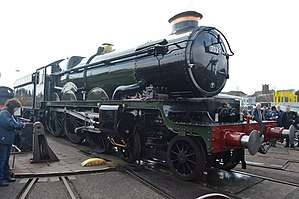GWR 4073 Class 7029 Clun Castle
7029 Clun Castle is a railway locomotive, built to the Great Western Railway Castle Class design shortly after Nationalisation by the Western Region of British Railways at the ex-Great Western Railway Swindon Works in May 1950 and named after Clun Castle.
| GWR 7029 Clun Castle | |||||||||||||||||||||||||||||||||||||||||||||||||
|---|---|---|---|---|---|---|---|---|---|---|---|---|---|---|---|---|---|---|---|---|---|---|---|---|---|---|---|---|---|---|---|---|---|---|---|---|---|---|---|---|---|---|---|---|---|---|---|---|---|
 Clun Castle in 2017 | |||||||||||||||||||||||||||||||||||||||||||||||||
| |||||||||||||||||||||||||||||||||||||||||||||||||
| |||||||||||||||||||||||||||||||||||||||||||||||||
| |||||||||||||||||||||||||||||||||||||||||||||||||
| |||||||||||||||||||||||||||||||||||||||||||||||||
British Rail
Its first shed allocation was Newton Abbot, and had a double chimney and a four-row superheater fitted in October 1959. Its most famous moment came on 9 May 1964 on the Plymouth to Bristol leg of a special train marked Z48 which was run to mark the record set sixty years earlier by "City of Truro" which was timed at 96 mph on the descent of Wellington Bank in Somerset. Preserved classmate 4079 Pendennis Castle which worked the Paddington to Westbury leg of the tour before melting its firebars has also been preserved. Its last shed allocation was Gloucester in May 1965. It hauled the last official steam train out of Paddington (to Banbury) on 11 June 1965. It was officially withdrawn in December 1965.[1]
| Location | Shed code | From |
|---|---|---|
| Newton Abbot | 83A | 31 May 1950 |
| Plymouth Laira | 83D | 29 December 1956 |
| Newton Abbot | 83A | 23 March 1957 |
| Old Oak Common | 81A | 2 July 1962 |
| Gloucester Horton Road | 85B | 5 October 1964 |
Preservation
Bought for its scrap value of £2,400 by Patrick Whitehouse in 1966, its ownership was then passed to 7029 Clun Castle Ltd. In preservation, it has been based at Tyseley TMD, now Tyseley Locomotive Works.
In 1967, carrying a Great Western livery, it hauled trains to mark closure of the GWR route to Birkenhead, from King's Cross to Newcastle and over the Settle-Carlisle Line. In 1972, it joined in the "Return to Steam" tours. After a major overhaul, it emerged in British Railways livery in 1985. In 1986, it hauled the last train from the old Birmingham Moor Street station. In the mid 1980s, some of the restoration work was undertaken by a government funded Community Programme scheme, managed by Sandwell Metropolitan Borough Council.
7029 returned to service in October 2017 at the Tyseley Open Weekend in BR Lined Green with the late crest on its tender, although fitted out with the necessary equipment the engine was not certified for mainline use. Clun Castle made its first moves on the mainline for 31 years in February 2019 when it went out on its light test runs, which included a trip to Stratford upon Avon.[2] Its loaded test run was to follow before working its first mainline train since October 1988.[3][4]
Preservation Photos
.jpg) 7029 leaving Birmingham Snow Hill working "The Zulu" in Mar 1967.
7029 leaving Birmingham Snow Hill working "The Zulu" in Mar 1967. 7029 at Chester General station, about to take the southbound "Zulu" special to Birmingham Snow Hill, 4 March 1967.
7029 at Chester General station, about to take the southbound "Zulu" special to Birmingham Snow Hill, 4 March 1967..jpg) Clun Castle at Tyseley in 1982.
Clun Castle at Tyseley in 1982..jpg) 7029 at Plymouth working "The Great Western Limited" in July 1985.
7029 at Plymouth working "The Great Western Limited" in July 1985. On display at Tyseley Loco Works awaiting an overhaul in Jun 2008.
On display at Tyseley Loco Works awaiting an overhaul in Jun 2008.
Bibliography
- Cadge, Richard (general ed.) (1985). Portrait of a record-breaker: the story of GWR No. 7029 "Clun Castle". Birmingham Railway Museum.
References
- http://brdatabase.info/locoqry.php?action=locodata&id=7029&type=S&loco=7029
- http://www.uksteam.info/tours/t19/t0219p.htm 7029's light test runs
- http://www.uksteam.info/tours/t19/t0221p.htm 7029's loaded test runs
- http://www.uksteam.info/tours/t19/t0228a.htm 7029's debut railtour
External links
| Wikimedia Commons has media related to GWR 4073 Class 7029 Clun Castle. |